CLASSIFICATION OF FUNGI
INTRODUCTION: –
Fungi are non-green, plantlike multicellular organisms belonging to the kingdom Fungi. They grow on dead organic matter in damp and warm places. Moulds, Yeasts, mushrooms are common examples of fungi. (STRUCTURE OF FUNGI) Moulds can be easily observed as they grow on food, bread, fruits, leather and even on barks of the tree. Mushrooms can be seen growing during rainy seasons on damp logs, walls, on the ground.
CHARACTERISTICS OF FUNGI: –
( tiny filaments of rhizopus that penetrate the substratum are called)
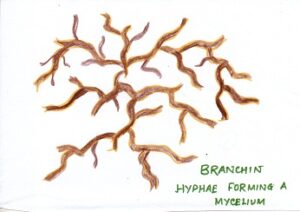
Fig#1 diagram of branching hyphae forming mycelium
* Fungi are non- green eukaryotes. ( cottony mass of fungus is called)
* It contains well membrane bound organelles like nucleus, mitochondria etc.
*It has a definite cell wall made up of fungal cellulose and chitin.
*Fungus thallus consists of tubular, branched and thread like structures called hyphae.
* The mass of hyphae forms a network which is called mycelium.
* The hyphae may be septate or aseptate.
* They do not contain chlorophyll, so they are heterotrophic.
* They cannot move freely hence non- motile.
* They reproduce mostly by spore formation (which is known as asexual reproduction) .
* Sexual reproduction may also take place sometime.
DIFFERENT TYPES OF FUNGI: – ( cottony mass of fungus is called)
A) MOULDS: It is a type of fungi grown on dead organic matter like decaying fruits, old and destroyed leather goods, and other perishable products ; that is why moulds are saprophytic in nature. They make their appearance in the form of a fine, fluffy and cottony mass. Rhizopus and Mucor are the two common bread moulds.
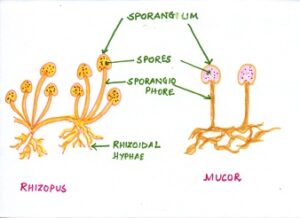
Fig#2 diagram of Rhizopus and Mucor
GENERAL STRUCTURE: – (STRUCTURE OF FUNGI) The cottony mass of both Rhizopus and Mucor consists of mycelium which is made up of branched hyphae. Hyphae are tiny filaments containing cytoplasm and nuclei. Their cell walls contain chitin. Living and growing part of fungi are hyphae. The mass of tangled hyphae is known as Mycelium. The hyphae is aseptate i.e. the cytoplasm is not partitioned by septa into separate cells. So the hyphae are multinucleate or coenocytic. These are of three types.
A) STOLONS: These run parallel to the surface and are slightly arched.
B) RHIZOIDAL HYPHAE: These are small and root-like hyphae produced in clusters from stolons at regular intervals.
C) SPORANGIOPHORES: These are unbranched erect hyphae that arise in groups opposite to rhizoidal hyphae. These bear sporangia which produce sporangiospores. ( simple mucor diagram)
In Mucor stolons are absent and rhizoids arise anywhere on the mycelium. In Rhizopus, many sporangiophores arise from a single node on stolonr, while in Mucor only one sporangiophore arises from a single node. ( hyphae that grow into a cottony mass)
NUTRITION: — (STRUCTURE OF FUNGI )Bread moulds are heterotrophs obtaining their nutrition from the substratum on which they grow. The growing hyphae penetrate into the substratum on which they grow and secrete enzymes. The enzymes break down organic materials like protein, lipids, and polysaccharides and digest they food outside the body of fungus. It is called extracellular digestion. The digested food is absorbed by the hyphae and is stored in the form of glycogen and oil droplets. ( rhizopus and mucor diagram)
RESPIRATION: In mould the mode of respiration is always aerobic i.e. fungus oxidises food in the presence of oxygen. To get oxygen from air, the bread mould always grows on the exposed surface.
REPRODUCTION: Reproduction is both asexul and sexual in both Mucor and Rhizopus. Asexul reproduction takes place by formation of non- motile spores while sexual reproduction takes place by conjugation of isogametes or similar gametes. ( STRUCTURE OF FUNGI)
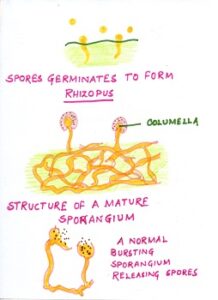
Fig#3 diagram of asexual reproduction of fungi
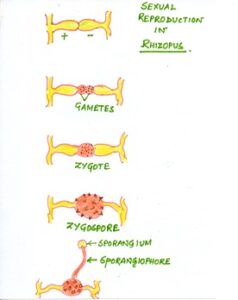
Fig#4 diagram og sexual reproduction of fungi
B) YEASTS: Yeasts are unicellular fungi of the genus Saccharomyce Yeast cell is very simple in structure and oval in shape. It has a distinct cell wall, nucleus and nucleolus. The cytoplasm is granular and consists of glycogen and oil globules. ( STRUCTURE OF FUNGI )
RESPIRATION:- ( STRUCTURE OF FUNGI)
Yeast respires anaerobically without using oxygen and produces carbon dioxide and ethyl alcohol. This is called fermentation.
C6 H12 O6 ——– C2H5OH+ 2CO2+ 2 ATP ( structure of mucor)
REPRODUCTION:- ( STRUCTURE OF FUNGI)
Yeasts reproduce asexully by budding. Sexual reproduction takes place by conjugation.
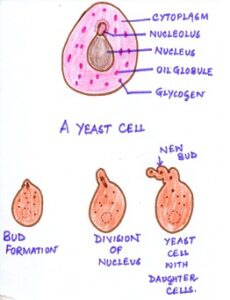
Fig#5 diagram of a Yeast cell and its reproduction by budding
USE:- Yeasts have several uses –
a) yeasts are used in the production of bread, beer and wine.
b) they are used as nutritional supplements as they contain vitamin B and vitamin E.
C) MUSHROOMS:- Mushrooms are the largest of all fungi. These can be seen in abundance during rainy season on damp logs , walls and on the ground. Mushrooms are umbrella-like structures. On the underside of the cap are many gills radiating put from the centre to the margin. ( rhizopus and mucor diagram)
Mushrooms are important food. These are cultivated on a commercial scale for their nutritional value as they rich in vitamin and proteins. Agaricus, Pennybun, Button mushrooms are ediblisjroom.
However, there are certain field mushrooms such as fly agaric and death caps( Amantia) which are deadly poisonous and should not be eaten. (STRUCTURE OF FUNGI)
STEPS IN MUSHROOM CULTIVATION ( hyphae that grow into a cottony mass)
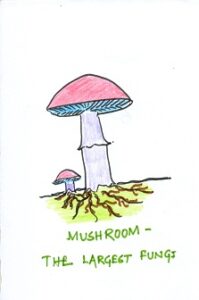
Fig#6 diagram of Mushroom
Before mushroom cultivation we have to be ready in three ways.
a) Growing season:- In plain land winter is the best time for growing button mushroom. In hilly area mushrooms can be cultivated through out the year.
b) Composting:- The compost is prepared by mixing the following ingredients in a certain proportion.
i) wheat or paddy straw
ii) chicken manure
iii) Ammonium sulphate
iv) urea
All the ingredients are mixed thoroughly on wetted staw . The compost which has a dark brown colour is kept at about 50°C for about one week.
c) Mushroom house:- It should be properly ventilated.
PROCESS OF CULTIVATION
i) Filling:- The compost is filled in trays.
ii) Spawning:- At first mycelium of the selected mushroom is introduced in the compost. After spawning, trays are arranged one above another in 4-5 tiers and left for a couple of days.
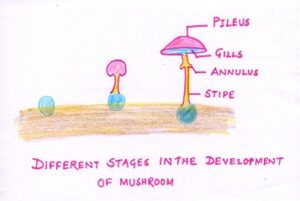
Fig#7 diagram of different stages in the development of Mushroom
iii) Casing:- A thin layar of soli is laid about 3cm over the compost surface. It gives support to the mushrooms , provides humidity and regulates the temperature. ( simple mucor diagram)
iv) Cropping and harvesting:- After 15-20 day’s of casing , first crop of pin heads is visible. Small white button stage develops 5-6 days after pin head stage. After that full grown mushrooms are harvested.
v) Preservation:- Since mushrooms are highly perishable, they can be preserved in proper way. They must be kept by vacuum cooling. They must be kept freezed in dry condition. Drying should be done by solutions of citric acid, ascorbic acid and brine.
PRECAUTIONS TAKEN IN MUSHROOM CULTIVATION
*There should be proper arrangement for circulation of air in the mushroom house .
* A temperature of 25⁰C for three days should maintained.
* After that a temperature of 16-18⁰C should be maintained.
DIFFERENCES IN BACTERIA AND FUNGUS
| KEY POINT | BACTERIA | FUNGI |
| 1) cellular organization | unicellular | multicellular |
| 2)cell wall | Made up of peptidoglycan | Made up of chitin |
| 3)nutrition | Autotrophic as well as heterotrophic | heterotrophic |
| 4)respiration | Aerobic or anaerobic | aerobic |
| 5) reproduction | Asexual by fission; sexual by conjugation | Aexual by budding, spore formation; sexual by conjugation |
FOOD PRESERVATION (STRUCTURE OF FUNGI)
Most of the edible products easily perish if not preserved because most of them contain high moisture. Here are some methods for food preservation.
1) HIGH TEMPERATURE OR STERILISATION:– By this process bacteria are killed by using steam, at very high temperature, pressure, in autoclave or in pressure cooker. Canned food is preserved by this process.
2) DEHYDRATION OR DRYING:– By this process moisture or water content is dried which helps to stop growth of microorganisms. Grains are preserved by this process. ( STRUCTURE OF FUNGI)
3) SALTING:– It is very old process. By this process plasmolysis of living tissue is done. This process is also known as ” curing”. Fish, meat, pickles,are preserved by this process.
4) PASTEURIZATION:– It is a technique but which milk is sterilised. By this process milk is heated upto 65°C for 30 minutes and then chilled quickly. By this process many germs causing typhoid, cholera, and diptheria are killed.
5) IRRADIATION:– It is the the latest technology of food preservation. By this process food is exposed to gamma rays or x- rays to kill food spoiling bacteria. Packed meat, fish, vegetables can be preserved by this process.
6) REFRIGERATION:– Chilling of milk and keeping vegetables, fruits, fish and meat, in a cold storage are popular method of preservation. Frozen fruits and vegetables retain their flavour and freshness for a long time. ( STRUCTURE OF FUNGI)
7) PRESERVATIVES:– Addition of preservatives in food help in plasmolysis and death of microorganisms. Some popular preservatives are vinegar, salt, mustard oil, citric acid which are organic preservatives also. Benjoic acid, sodium benzoate, ascorbic acid and propionic acid are chemical preservatives.